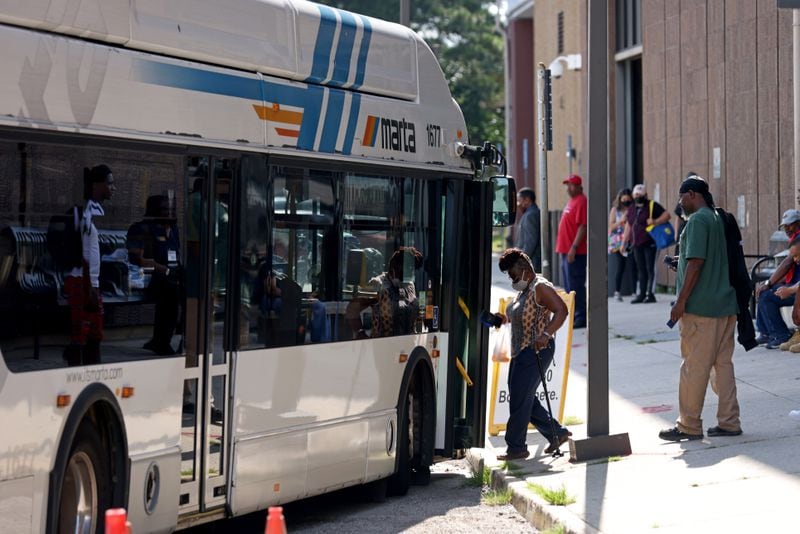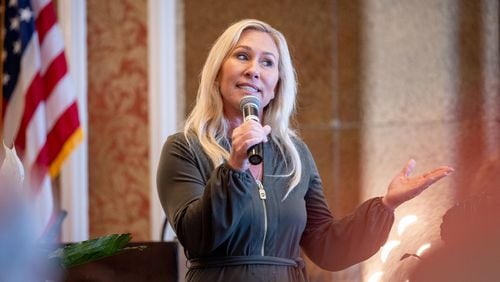MARTA riders driven away by the coronavirus pandemic have begun to return to trains and buses, but the transit agency faces plenty of challenges as it tries to lure back more customers.
More metro Atlanta residents are working from home in what looks like a permanent lifestyle change. Ride-hailing services are still poaching customers from public transportation. Staffing shortages have plagued transit agencies, disrupting service. And the pandemic continues to roll in waves across the country.
Metro Atlanta’s largest transit agency is trying a variety of strategies to attract customers in the short run, even as it plots a long-term expansion. It’s unclear when or if MARTA’s ridership will return to pre-pandemic levels. But with federal COVID-19 relief funds dwindling, the agency’s long-term financial health depends on the return of paying customers.
Interim CEO Collie Greenwood believes they will come back.
“I think we would have all cleaned out our bank accounts if we didn’t feel that way,” Greenwood said.
Transit agencies across the country faced challenges long before COVID-19. Nationally, bus ridership fell 15% from 2012 to 2018 and rail declined 3%, according to a recent academic study. The researchers found competition from ride-hailing services, cheap gasoline, fare increases, telework and other factors contributed to the decline.
Then the pandemic hit. When Georgia schools and businesses closed at the beginning of the pandemic, metro Atlanta transit agencies lost two-thirds of their passengers compared with the previous year, an Atlanta Journal-Constitution analysis of federal data shows.
Most customers haven’t returned. In March, the number of trips on MARTA trains was still just 42% of the number of trips for the same month in 2019, the last full pre-pandemic year, the AJC analysis found. Bus ridership was a little better at 51% of its pre-pandemic level.
Kari Watkins, a Georgia Tech professor and one of the researchers who studied national ridership trends, said the pandemic accelerated trends such as telework and home shopping that diminished trips on public transportation. But she said transit proved its value in transporting essential workers such as hospital employees during the pandemic.
“In a lot of communities, there’s more respect for what transit does than there was before,” she said.
Georgia Tech won a $1 million federal grant in 2020 to launch a center to study declining transit ridership and how agencies can recover from the pandemic. Though its work is not complete, Watkins sees promise in several strategies MARTA is exploring.
One is a new pilot program for the on-demand service MARTA Reach. Under that program, customers in a few neighborhoods can summon shuttles to take them anywhere in those neighborhoods. MARTA launched the service in February and is already expanding it.
Watkins said Tech’s research shows on-demand services such as Reach can help transit agencies attract customers in areas where it may not be economical to provide regular bus service. She said such services may be especially effective in combination with another strategy MARTA is exploring — redesigning its regular bus system.
Credit: Jason Getz / Jason.Getz@ajc.com
Credit: Jason Getz / Jason.Getz@ajc.com
MARTA has hired a consultant to guide the most extensive redesign of its bus network in decades. The agency faces two choices: keep a system that provides less frequent service over a broad geographic area or offer more frequent service on fewer routes. The latter option would increase ridership by making bus service more useful in key areas, the consultant says.
Those options closely resemble MARTA service during the pandemic. The agency eliminated most of its bus routes at the beginning of the pandemic but increased service on the remaining routes.
It later restored all routes. But in recent months it’s scaled back the frequency of service amid a shortage of bus drivers and technicians. Armed with retention and recruitment bonuses, MARTA is on a hiring binge and hopes to restore full service this summer.
Watkins said offering more frequent bus service on key routes and on-demand shuttles in other areas could be an effective way to serve more passengers. It’s a strategy MARTA is considering, though Greenwood stressed no decisions have been made.
MARTA has other long-term strategies to attract riders. It’s encouraging commercial and residential development in underused parking lots at its rail stations. It debuted its most recent development last month at King Memorial station.
The agency also is buying new rail cars, renovating stations and expanding service in Atlanta and Clayton County. Greenwood believes those investments will attract riders.
In the short run, MARTA is restoring full service, cleaning vehicles and stations frequently and upgrading its rider app to provide more accurate information about arrivals and departures.
Greenwood sees hopeful signs. He said MARTA trains have been packed during sporting and holiday events. He said that shows people are becoming comfortable with riding transit again. His goal is to make MARTA more attractive so they come back.
“If it’s right there in front of you and it’s clean and its safe, it’s professional, it’s easy to access,” he said, “then I think MARTA’s done its part.”
About the Author








